Japan loves its green tea.
So much so, that there are upwards of 10 major Japanese green tea varieties. They all come from Camellia sinensis, the tea plant, but are grown, harvested, and processed differently for unique flavor profiles.
Each also comes with its own set of instructions for brewing, serving, and drinking. The tools you use greatly affect the quality.
So naturally, in Japanese tea culture, the tea pot matters. A lot.
Other utensils do too: the cups, tea scoop, and storage box.
For years, I was used to the simplicity of tea bags – and Japanese tea culture seemed too complicated. But with a few tea utensils and brewing rules to keep in mind, your cup of Japanese green tea can take you to a whole new world of flavor, warmth, and that serene caffeine buzz.
With each brew, Japanese tea pots and cups provide a refined experience that you’ll want to share with your loved ones. So, here’s everything you need in a traditional Japanese tea set – and a few brewing tips for an extra nice cup of tea.
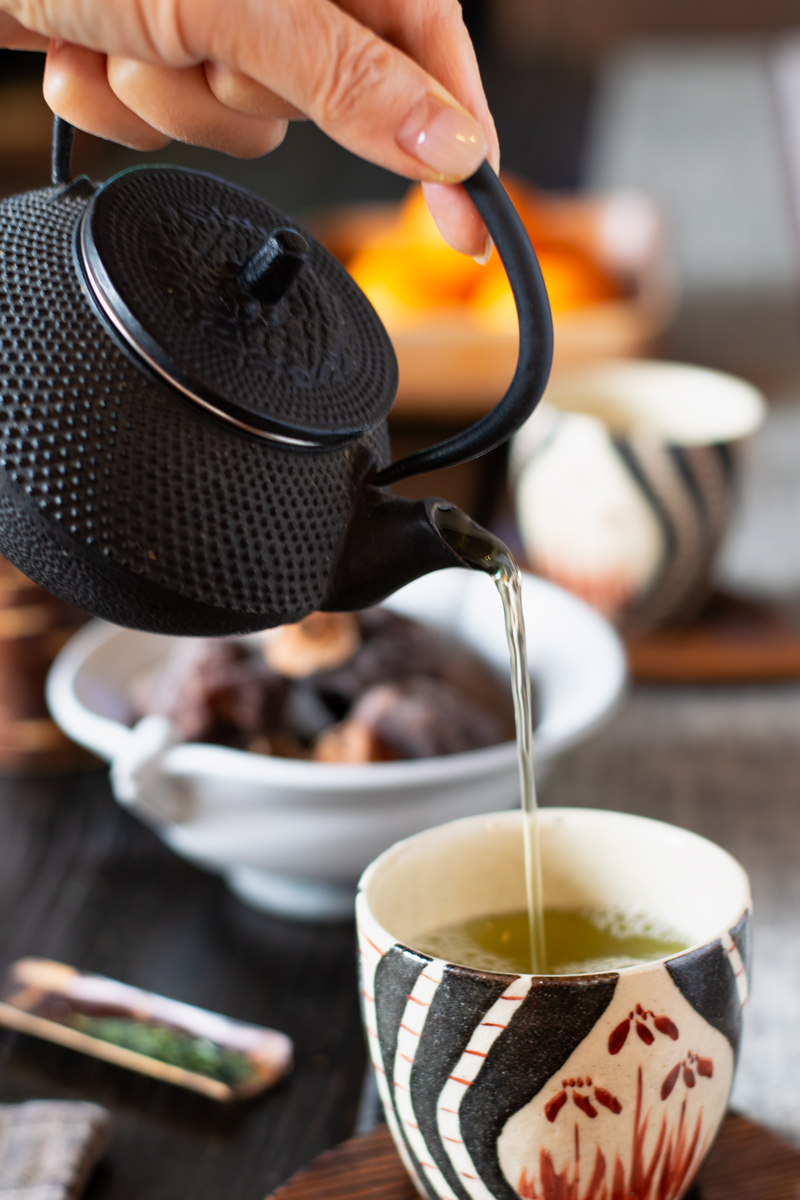
Types of Japanese Tea Pots – Kyusu (急須)
Japanese teapots come in a few different shapes – and they are all called “kyusu” (despite the common misconception that the word refers to a specific side-handle teapot type).
The kyusu, Japanese tea pots, can be made of ceramic, porcelain, or iron; enameled or not. Clay and iron react with the tea, changing its flavor and building up a seasoning over time – making your Japanese tea pot even more special.
We categorize Japanese tea pots by their build – and their sizes, and shapes of handles, strainers, and spouts can make a world of difference. The easiest way to tell one type of kyusu from another is the position of the handle (significantly affecting the pouring experience).
However, material and shape alone are not enough to help you choose the right teapot.
To truly get the best Japanese tea set for personal use, choose the type of tea you’ll mainly use it for first, and then consider size, materials, and finally the handle type.
Side-handle Teapot – (横手急須, Yokode Kyusu)
Yokode Kyusu is the most popular type of Japanese teapot. It’s the small, cute, round teapot with a left-pointing, tapering handle perpendicular to the spout.
Its side handle is a detail that makes it universally recognizable as a Japanese tea pot. But it’s more than just style – the handle is hollow, helping it cool down quickly, and the position makes elegant tea pouring possible with only a slight turn of your wrist.
Easy to use and surprisingly elegant to pour from, this side-handle kyusu is the right size for a couple of small cups of tea – a standard kyusu can hold between 200 and 300 ml of water. They normally have built-in strainers, but you may find models with removable nets.
Being a common choice for a daily driver teapot, kyusu are used to brew loose-leaf green tea like sencha (the most common daily driver tea in Japan), kabusecha, or gyokuro.
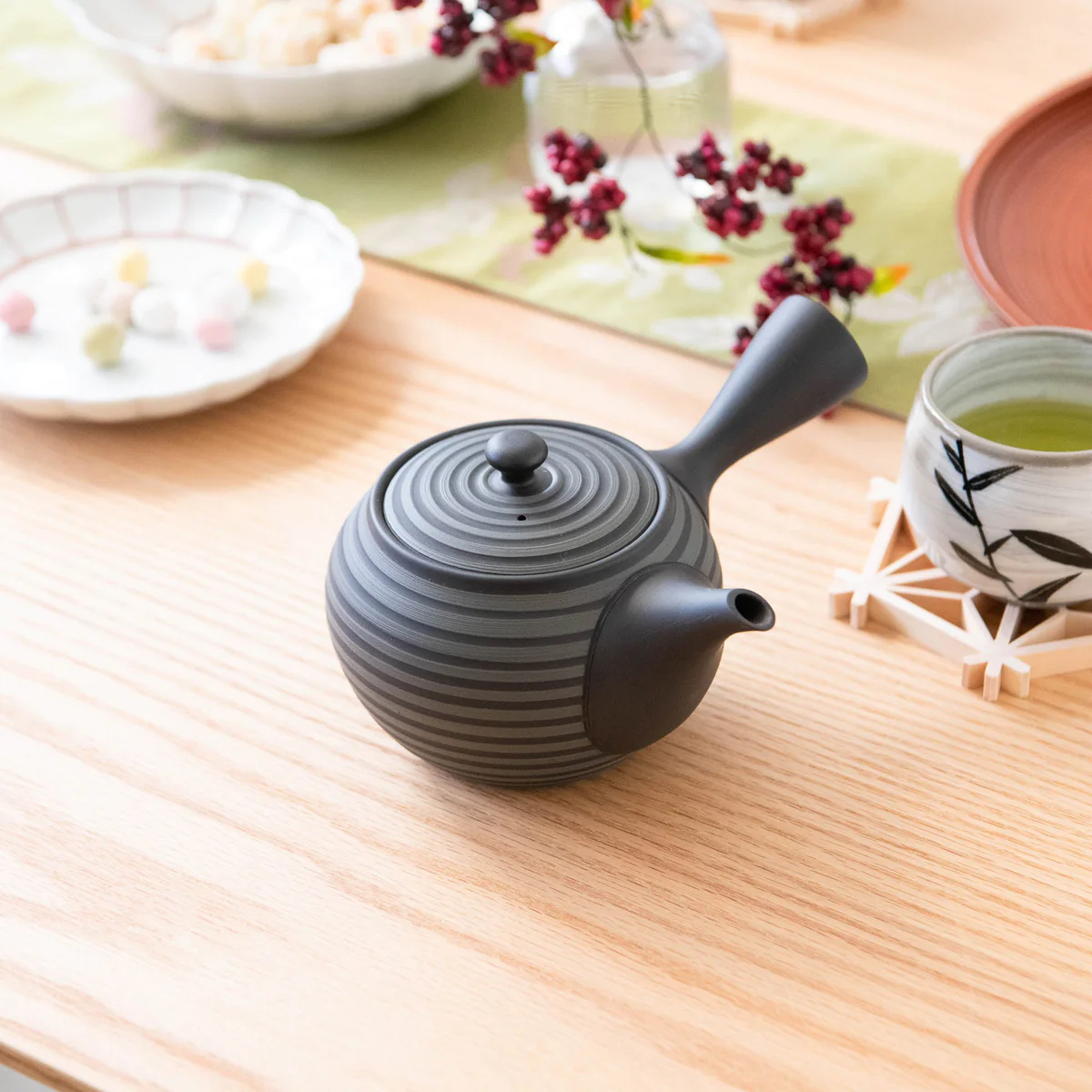
Handle-less Teapot (宝瓶急須, Houhin Kyusu)
Small enough to hold in one hand, pressing the lid with the other one, the houhin doesn’t even need handles. This tiny teapot rarely holds more than 180 ml of liquid.
Since it has no handles, you can’t use it with piping hot water – instead, the water is cooled before pouring into the teacup. That’s all part of the design, because houhin is made for high-quality teas: gyokuro, high-grade sencha, or white tea, all typically brewed at lower temperatures.
Its design based on the ancient Chinese gaiwan, the houhin is made of porcelain so it doesn’t affect the flavor of tea, and is quite thin, allowing for heat to disperse faster.
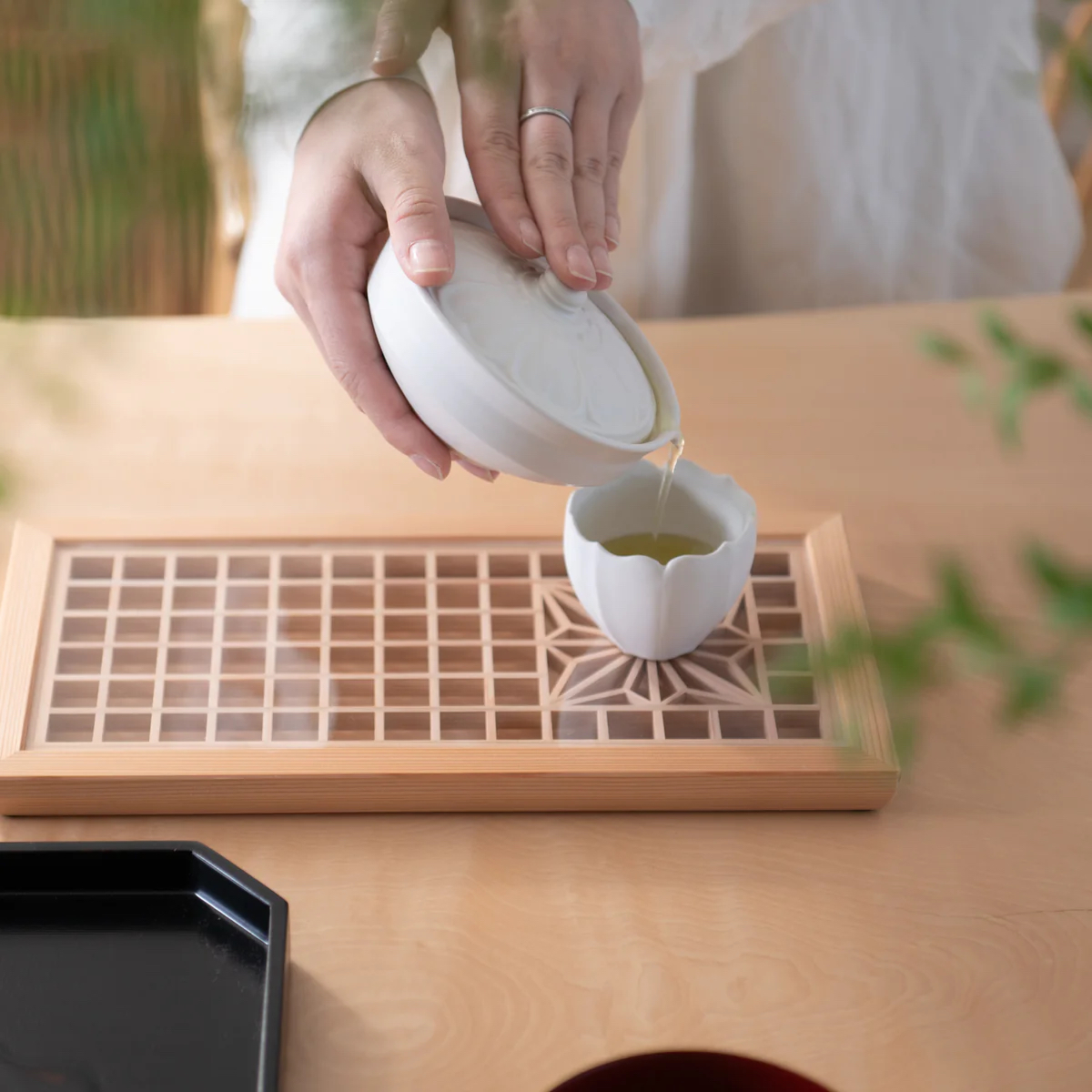
Back-handle Teapot (後手急須, Ushirode Kyusu)
Very similar to what we consider a “teapot” in the West, an Ushirode Kyusu has a backward-facing handle.
These are usually larger and used for brewing Chinese and European teas, but they’re also great when you want to brew several cups’ worth of sencha.
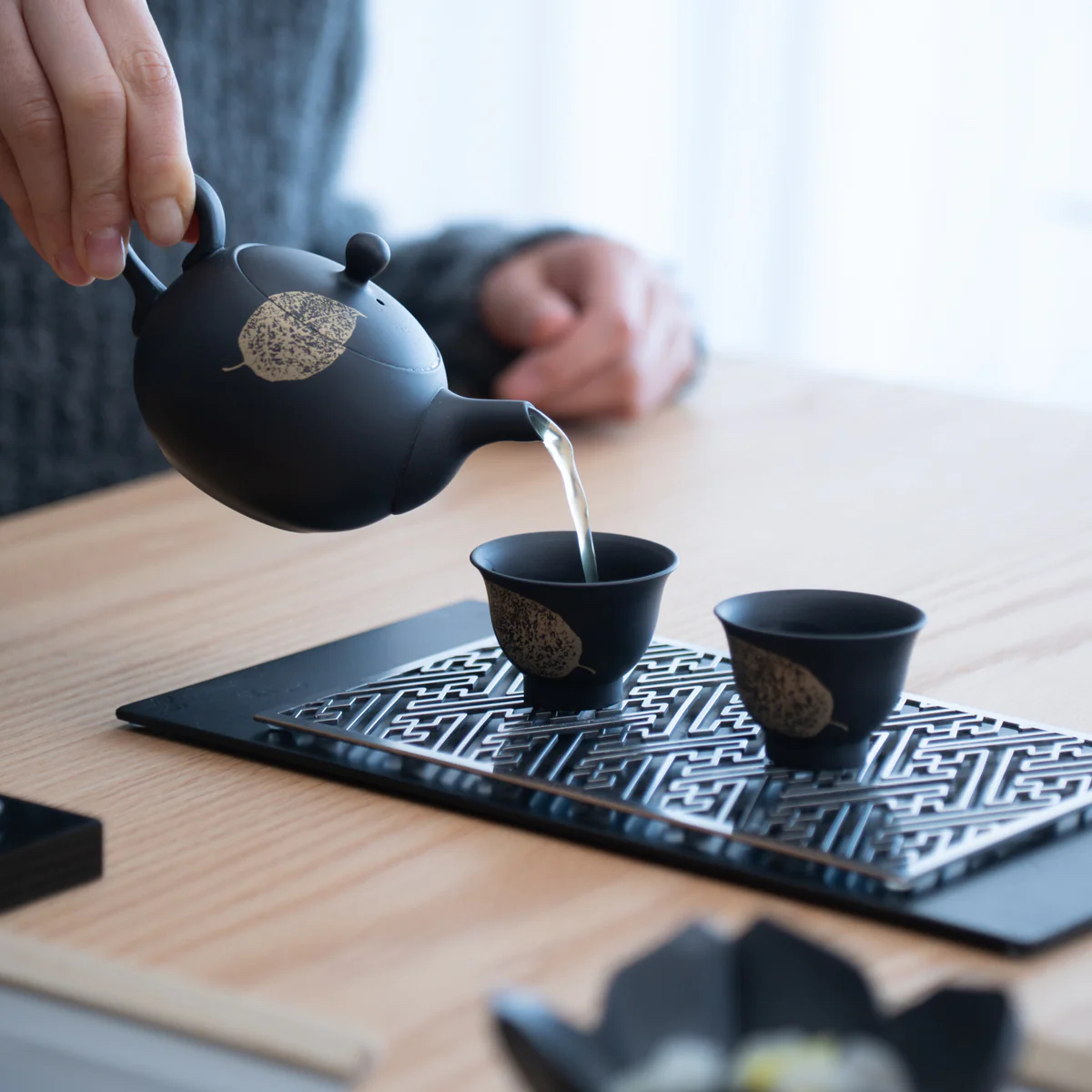
Top-handle Teapots (上手急須, Uwade Kyusu)
The top handle of Japanese teapots was used for a specific purpose – to hang the pot over fire, and boil the water in. Today, these are no longer kettles; the large top-handled vessels evolved into their own category of teapots (made for brewing, not boiling).
Dobin (土瓶)
Dobin is an earthenware teapot. Even the Japanese word literally means “earth pot”.
However, it’s not all clay – the top handle of the teapot is usually made of another material like bamboo, rattan (straw), or plastic. That way, the handle doesn’t get too hot, allowing you to pour even piping-hot tea with ease.
The design allows boiling water, and a lot of it, so a dobin is perfect for less sensitive teas like hojicha, bancha, and genmaicha.
The position of the handle also helps you hold this big teapot steadily. In fact, it’s a common choice for a teapot used at home, because of its larger volume – the Japanese dobin usually hold anywhere between 250 and 600 ml of liquid.
Another quality-of-life feature is the removable strainers dobin usually come with, making cleaning much easier.
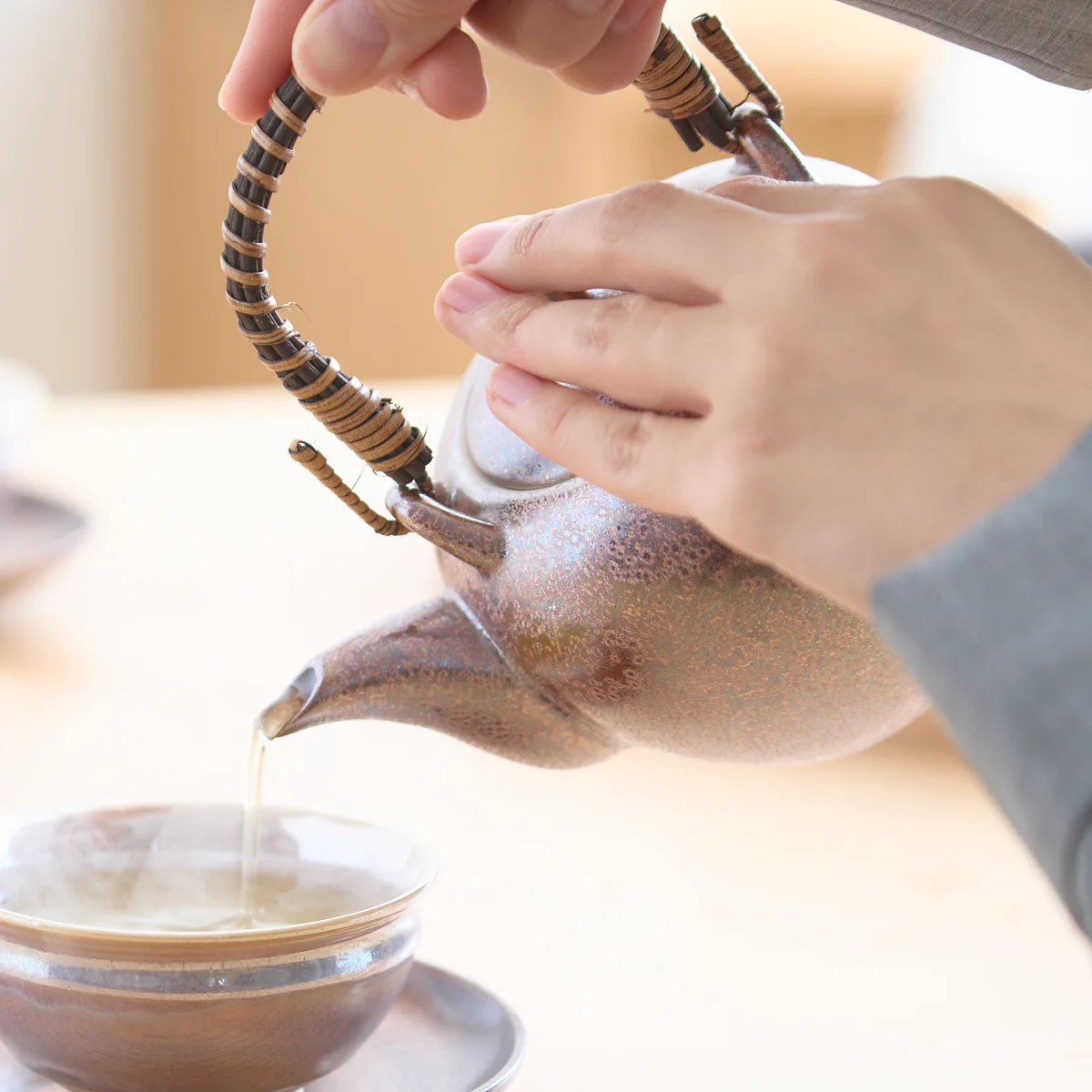
Tetsubin (鉄瓶) and Tetsu-Kyusu (鉄急須)
Dark and cool, its texture dotted with intricate designs, heavy and sturdy… The cast iron tetsubin is an old type of kettle, today mostly used as a tea pot.
Whether you like single, quiet moments or tea time with friends and family, there’s a perfect size tetsubin for you out there. They can hold anywhere between 150 ml and 5 liters of liquid.
While they’re usually black, they come painted in different colors too.
However, most tetsubin today can’t be used to boil water – they’re lined with an enamel coating, which can’t handle the heat. The correct term for enameled tetsubin is tetsu-kyusu, but that expression is not particularly widespread. If you’re lucky to own an old-school tetsubin that’s just cast iron, without enamel on the inside, you can use it to both boil and brew. You can even hang it over fire, as people used to do in the past.
Non-enameled, pure cast iron tetsubin come with more benefits. A pure iron pot will react with your tea, giving the sharp tea a mellower taste and neutralizing the astringency of the green drink. It’s also believed to make the water boiled in it smoother.
On the other hand, an enameled tetsu-kyusu is easier to clean and doesn’t affect the flavor of your tea.
Tetsubin usually come with removable strainers, which makes maintenance easier.
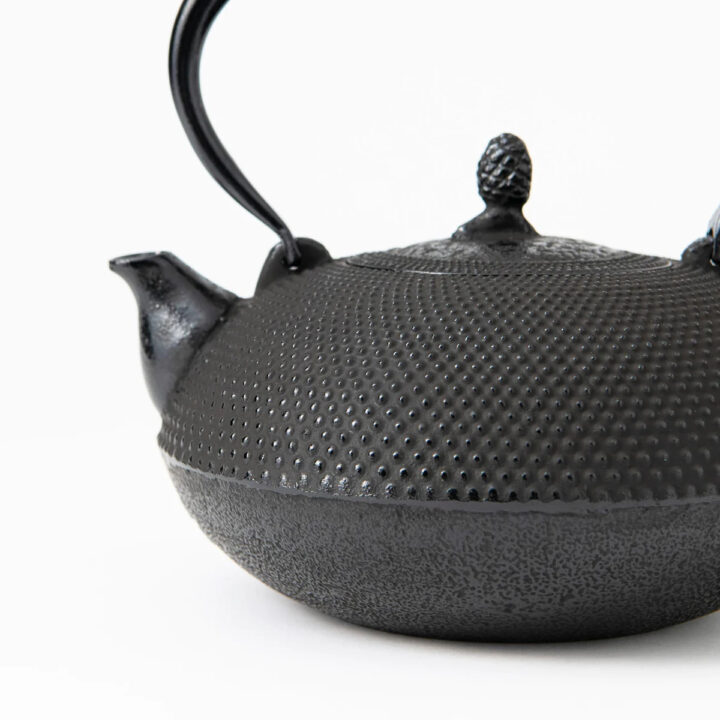
Traditional Japanese tea sets are not complete without…
Water Cooler (湯冷まし, Yuzamashi)
From sencha and gyokuro to white tea, many types of tea get burnt if you use near-boiling water. A cooling cup is a common (and much needed) part of any tea set made for delicate teas with lower brewing temperatures.
It’s essentially a back- or side-handle cup. It has no lid, to allow the water to cool quicker. You don’t have to wait long for your water to cool down – the act of pouring the water from the kettle to yuzamashi and finally to the teapot helps speed up the process.
Japanese Tea Cups
Western mugs are often gigantuous compared to Japanese tea cups. The largest Japanese tea cups, yunomi, can hold at most 160 ml (usually closer to 100 ml). Find in-depth information about types and materials of Japanese tea cups on my blog here.
Tea Scoops
Stainless steel spoons may react with the green tea – it can oxidize both matcha and tea leaves, counteracting their antioxidant properties.
Of course, you can simply use a wooden spoon to measure your tea. Or, complete your Japanese tea set with an appropriate scoop for your favorite tea.
Depending on the type of tea, you’ll need either a chashaku (茶杓) for matcha, or a chasaji (茶匙) for tea leaves. They usually hold approximately half a teaspoon of tea – or about 5 g of tea leaves, but some chasaji are bigger, the size of a teaspoon too.
Chashaku is a long bamboo scoop for matcha.
Chasaji is used for tea leaves. It’s broader, shaped a bit like a shoehorn, and can be made of wood, copper, brass, or some other metals.
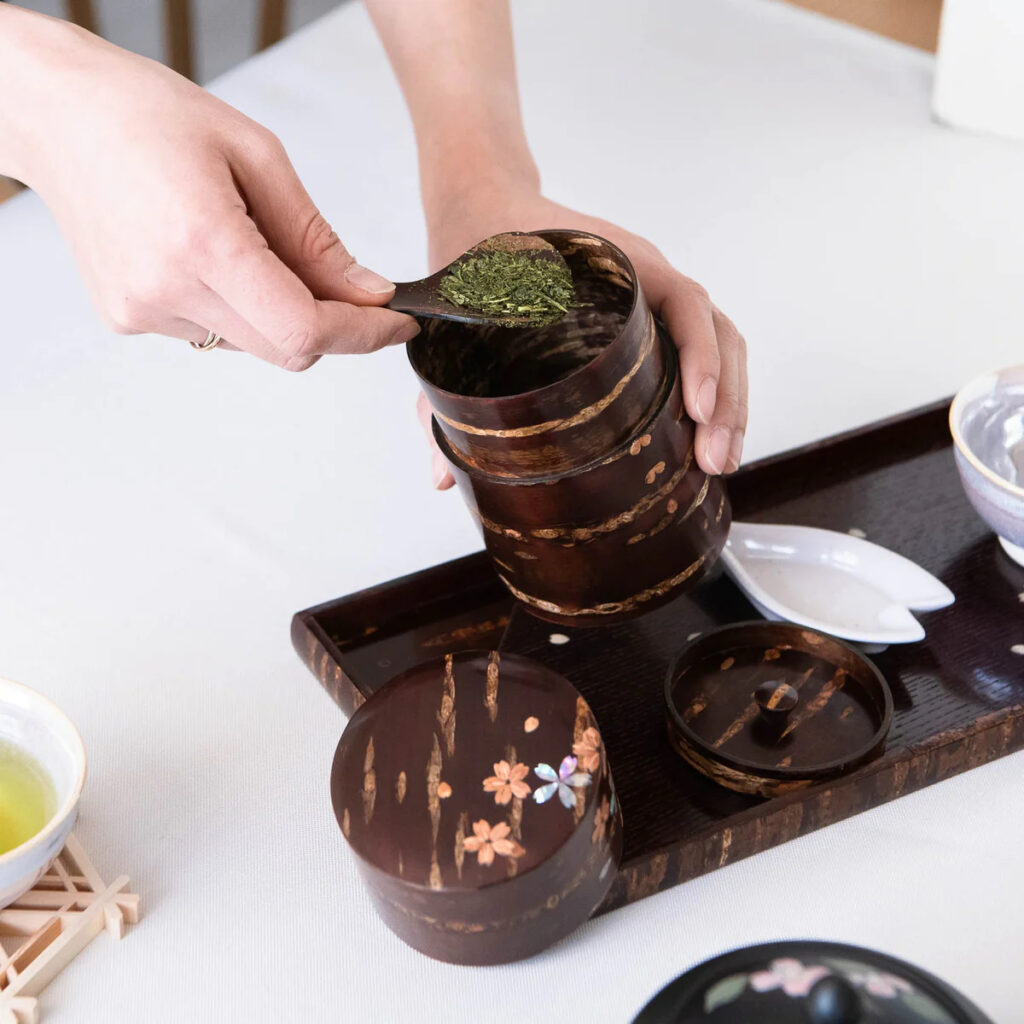
Japanese Tea Storage – Tea Caddies
Like most fine things in life, tea leaves suffer damage from sunlight, humidity, smells, and even oxygen. To get consistently tasty cups of green tea, you need to protect your tea leaves from outside influence.
You’ll need an opaque, air-tight canister to keep your tea safe from deterioration. The Japanese developed a few options: Chazutsu (茶筒), Chakan (茶缶), Chaire (茶入), and Natsume (棗).
The first two, chazutsu and chakan, are used for loose-leaf teas and have a similar cylindrical design. Chazutsu are wooden, chakan are metal. They often feature a set of lids for a better seal.
The latter chaire and natsume are boxes used for the powdered matcha tea. Natsume are tiny, rounded, lacquered boxes, while chaire are large-volume ceramic containers for matcha. Chaire often come in a silk bag for additional protection.
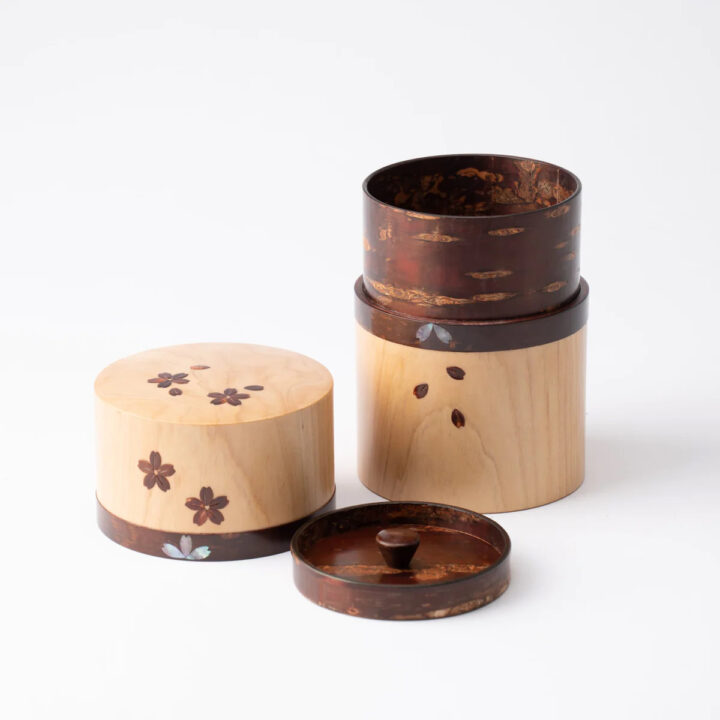
A chazutsu keeps your tea perfectly safe, in an anti-bacterial, air-tight environment.
Tea Set Box (茶櫃, Chabitsu)
If you get a whole Japanese tea set (the teapot and cups, and perhaps an accessory or two), chances are it’ll come packed in a big, round box made of wood. It’s called chabitsu – a lidded chest for tea storage.
It’s not only a convenient way to keep your tea set safe from dust when not in use – the lid also doubles as a serving tray for an elegant tea presentation.
Tips for Storing, Brewing and Pouring Japanese Tea
Fill Infuser Halfway
Green tea leaves rapidly expand when you put them in water – so expect your tea to unfold and grow while brewing. The leaves will also need some wiggle room to give out maximum flavor. That’s why you should never overfill your infuser or teapot with tea leaves.
Keep the Teapot Lid Closed
When I made my first cup of green tea, I just poured hot water over tea leaves and let it brew for a minute. It had a flavor so mild (so much milder than store-bought) I thought I’d never understand the appeal of replacing your coffee/soda with tea. It just wasn’t enough excitement for my overstimulated western taste buds.
Well, turns out, that’s not how you make green tea. Made properly, it does have a heavenly flavor that I completely missed the first few tries. My mistake – leaving the teapot lid open while brewing. I let all of the aroma escape with the steam.
Learn from my mistakes, maximize flavor: close the lid on your Japanese teapot when brewing tea.
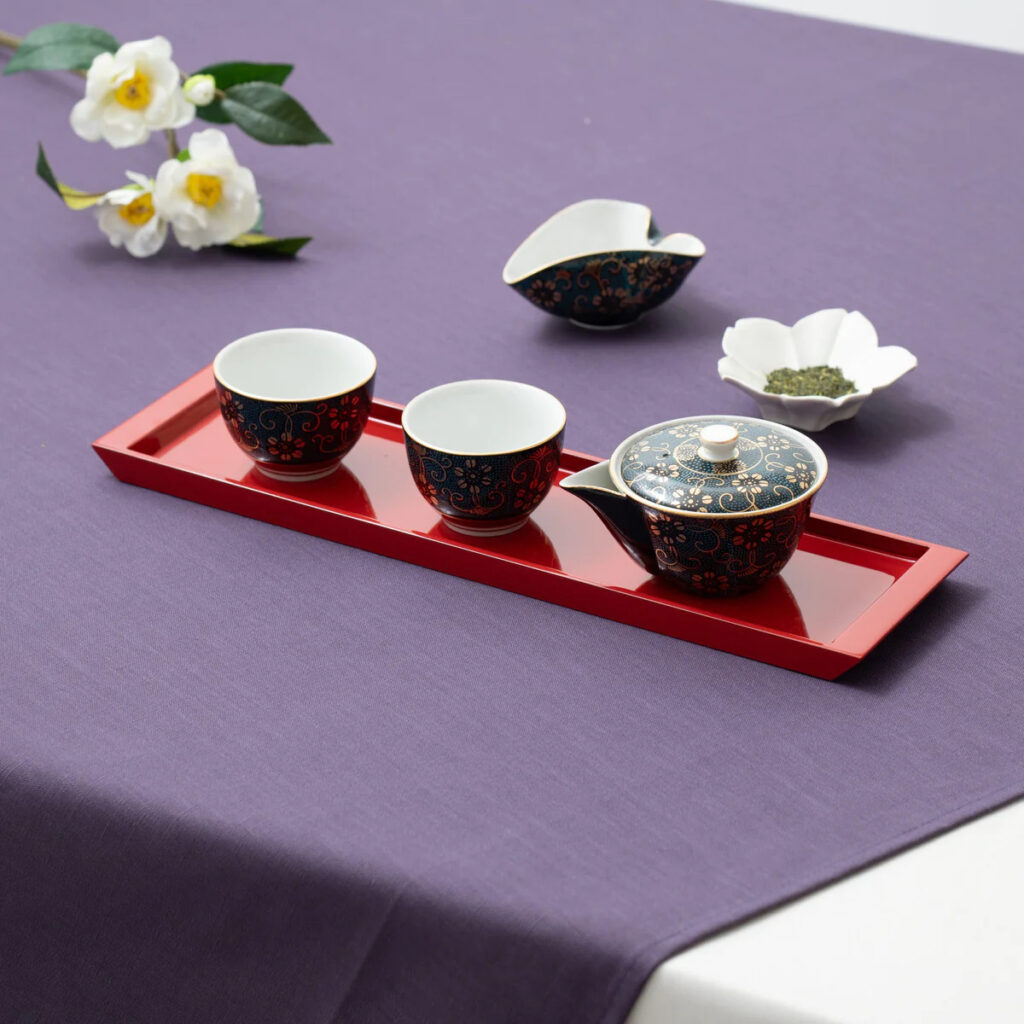
A houhin teapot, teacups, and a yuzamashi water cooler in the back.
Perfect Water Temperature (without a yuzamashi cooler)
Another rookie mistake I made several times before I finally learned better is – burning my green tea. It gets this extremely astringent taste when burned, it really ruins the experience.
Even daily green tea like sencha is quite delicate, and it shouldn’t come in touch with boiling-hot water (the ideal brewing temperature for sencha is around 80°C -> 180°F). So – you need to cool your water before getting it from the kettle to the teapot. Usually this is achieved with a yuzamashi water cooler.
However, you can use this method too. It works best if you’re making 3 or 4 cups of tea:
- Pour water from the kettle into your teacups first. Ideally, hold your kettle up high so the water gets in touch with as much air as possible. Fill all teacups.
- Then, again holding your cups high up in the air, pour the water into the teapot. Start with the teacup you filled first.
- Use an additional tea cup if the water still feels too hot (kettle -> teacup -> another teacup -> teapot).
It’s really hard to tell how hot your water is without a thermometer. I test it by holding my hand above the water for a bit, feeling the steam. The steam emanating from the water shouldn’t be scorching hot, but barely bearable.
Don’t Over-brew
Most green tea can be steeped two times. That is – if you don’t brew for too long, and don’t leave your tea leaves covered in water after brewing.
It’s important to completely empty your teapot – not only does it keep your tea leaves brew-ready, but the last few drops contain the most flavor too.
Pour Equally
When distributing your tea between tea cups, don’t fill one cup and then the other.
Instead, pour tea little by little, alternating between the cups.
The first drops of tea to pour out are the weakest, almost water, and the last drops in your teacups will be super strong. You want to get an equal mixture of strong and weak tea in each cup, for everyone’s enjoyment.
Alternatively, you can pour all of the brewed tea into the yuzamashi, let it mix in that vessel, and then pour it into teacups.
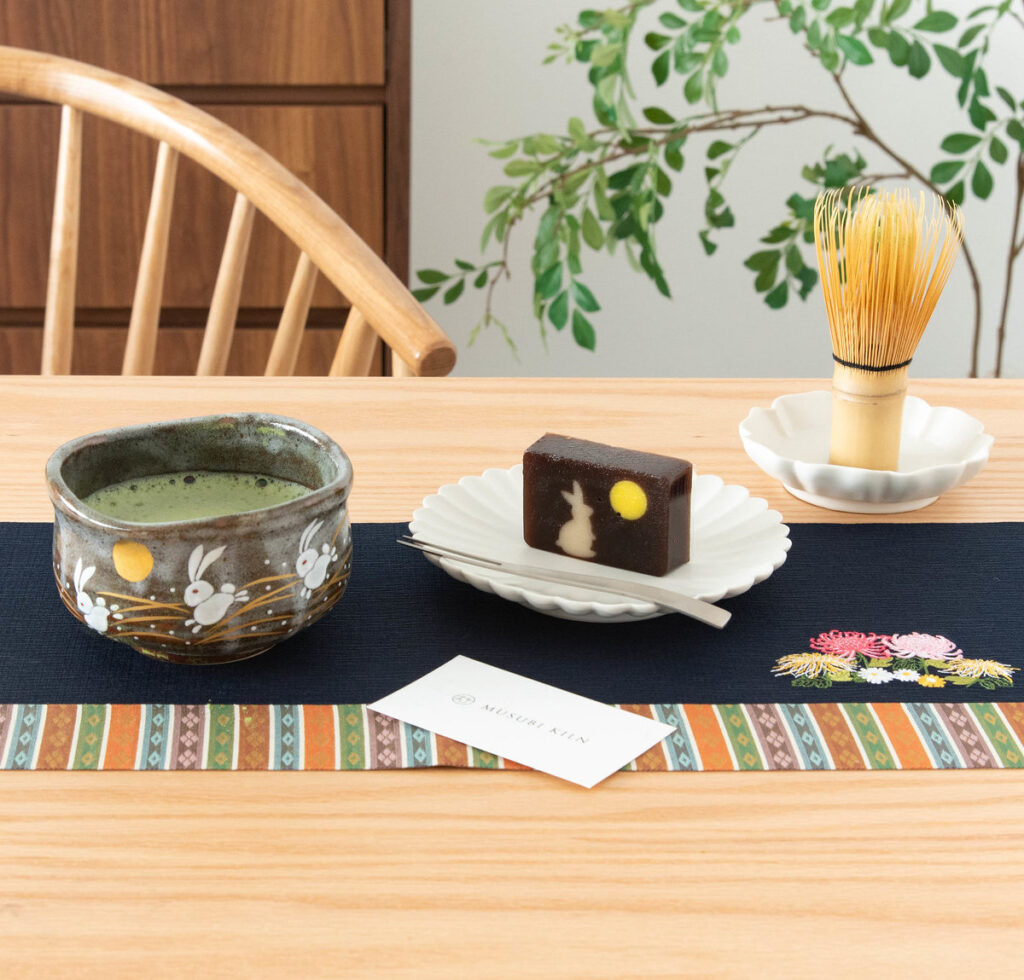
Do combine your Japanese tea with mildly sugary sweets – it’s a heavenly combo.
Storing Japanese Loose Leaf Tea
If there is one thing you MUST protect your green tea leaves from, that’s humidity.
If you use a chazutsu (tea caddy), or another tea storage box, make sure it’s completely dry before using it. Only wash it when really necessary.
Kyusu Maintenance
This should go without saying, but you should never clean your earthenware with dish soap. That includes your kyusu.
Get Yourself The Perfect Japanese Tea Set
Japanese green tea is a blessing on so many fronts. Not only is it one of the healthiest energy drinks you can have, but it’s also a delicious beverage with many slight variations and options to suit everyone’s taste.
However, brewing a good hot cup of Japanese tea can prove difficult if you don’t have the right tools – so get yourself the best Japanese tea set you can get your hands on.
You’ll feel the difference from the first sip.
An authentic Japanese tea set is a perfect gift for tea lovers. Choose the best Japanese tea pot with a beautiful design at Musubi Kiln. Explore their wide selection of traditional Japanese teapots made from different materials. Choose from porcelain teapots, ceramic teapots, iron teapots, or clay teapots.
Learn More
Matcha Green Tea - Why It’s So Healthy
ABOUT THE AUTHOR

Dunja Djuragic Dugandzic
Dunja believes simple, straightforward, a little cheeky, and very informative writing can change the world. From teenage years, her fascination with the Japanese way of life continues to grow - and so does her research. Since 2015, she writes content about Japan, travel, world cultures and heritage, crafts and art, printing technologies, and a variety of digital products.

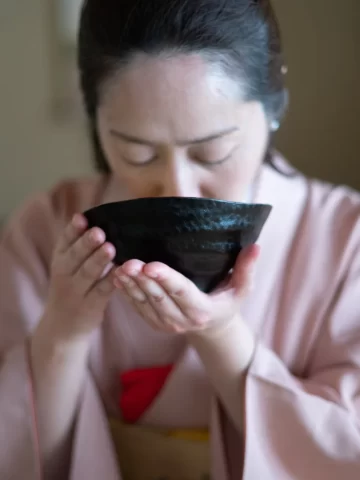
Leave a Reply